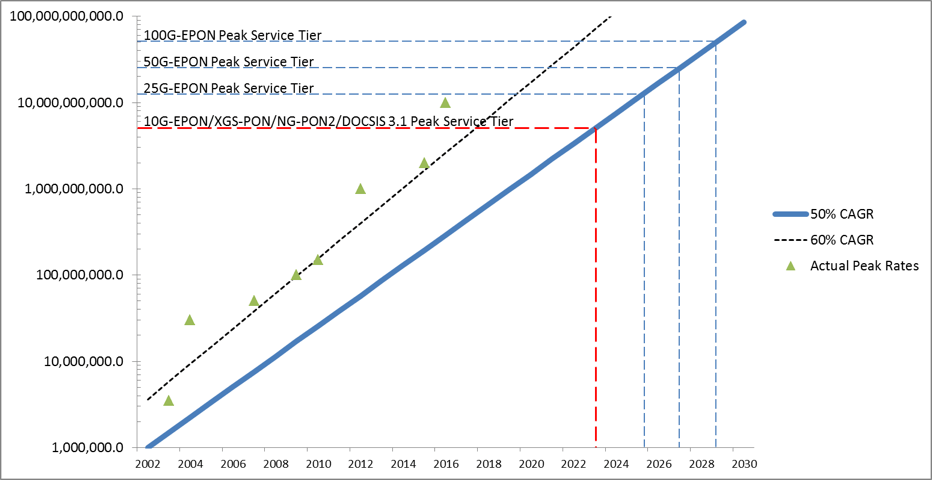Fiber
CableLabs’ Optical Center of Excellence Expands to Support PON

Key Points
- The optical lab’s capabilities range from innovation to prototyping and testing.
- Operators can use the lab to explore the benefits of 10G PON, 25G PON and 50G PON.
- It also offers them a space to learn how to integrate PON technologies into their networks.
Optical communication — transmitting light waves through fiber optic cables — continues to be the foundation for providing high-speed broadband services to consumers. Whether the network solution is 100 percent fiber to the home or fiber is just an overwhelming majority, you’ll find fiber optics at the root of the solution. To acknowledge the foundational prominence of fiber optics in our industry, CableLabs is expanding the capabilities of our Optical Center of Excellence (OCE) to include state-of-the-art passive optical networking (PON) equipment.
How Our Optical Lab Helps Move the Industry Forward
Technology labs are an important part of any company whose role is to innovate and develop new solutions. The value of a technology lab can be significant and multifaceted, impacting various aspects of innovation, research, development and practical application. Particularly at CableLabs, the OCE provides important capabilities for the broadband industry.
Innovation. The OCE serves as the hub of optical innovation at CableLabs, allowing for experimentation, analysis and simply exploring new opportunities. Over the past several years the OCE has been used to explore and demonstrate the use of coherent optics in network access, wavelength switching, quantum key distribution and the use of fiber to sense environmental events, to name a few applications.
Development. Equipment in the OCE allows optical researchers to dive into the details of an innovation that shows promise as a potential solution in the network. Looking for ways to cost-reduce a solution is an important step in developing an idea into a product that can be deployed in a real network.
Validation. At CableLabs, we commit a lot of time to developing specifications for future technologies and solutions. Part of specification development involves validating certain assumptions, such as receiver sensitivities, link budget, modulation schemes, distances and many other aspects of an optical solution. The OCE contains the equipment to perform these validations.
Prototyping and testing. An important part of any R&D organization is to prototype solutions and test operation. In the case of PON, the OCE not only provides a testbed for a prototype of coherent PON, but it also provides an environment for testing interoperability of network devices built to legacy PON technologies.
Future-Proofing Passive Optical Networking Technologies
As broadband operators plan the evolution of their network beyond 10G, the OCE at CableLabs will provide a workspace in which the capabilities of next-generation FTTP technologies and standards can be tested. The OCE at CableLabs will enable operators to understand how 10G PON, 25G PON and 50G PON will enhance the user experience in their network.
The OCE will also be an environment in which to learn how these technologies can be integrated into operators’ networks. As next-generation PON takes shape, CableLabs will be prepared to usher in future PON technologies as solutions for service providers.

Fiber
Why Accelerating FTTP Adoption Is Critical to Leveraging PON’s Potential

Alongside the hustle and bustle in the cable industry to deploy DOCSIS® 4.0 technology, another 10G solution quietly plods along with pinpoint precision: fiber to the premises (FTTP). In FTTP, the premises can represent a home, business, campus, multiple-dwelling unit, etc.
Despite what fiber overbuilders might want you to believe, the cable industry has always embraced fiber-optic technologies in its access networks, beginning with the dominant media component in hybrid fiber coax (HFC) networks. For the past handful of years, the industry has also embraced passive optical network (PON) technology to deliver services over FTTP networks, especially in greenfield deployment scenarios.
CableLabs has consistently been in lockstep with our operator members when it comes to the development and deployment of wired technologies — tackling new versions of DOCSIS technology and innovating around enhancements to the HFC network. Now, CableLabs is flexing once again with an increased focus on FTTP networks and PON technologies, along with an adjustment of resources to support it.
We continue to be focused on DOCSIS 4.0 technology solutions as operators begin deployments, but now we’re also getting laser-focused on FTTP adoption. This technology lays the foundation for operators to deliver lightning-fast, symmetrical speeds and increased reliability while also reducing their own maintenance costs later on down the road.
Join Our Working Groups
This week, we’re kicking off this work in earnest with the launch of two new working groups. One will focus on optical operations and maintenance, and the other will focus on specifying a DOCSIS framework for provisioning International Telecommunication Union (ITU)-based PON technology. If your company is involved in these technologies, you should be involved. We’re getting started Thursday, October 26. To learn more or join the groups, click the button below to reach out to us.
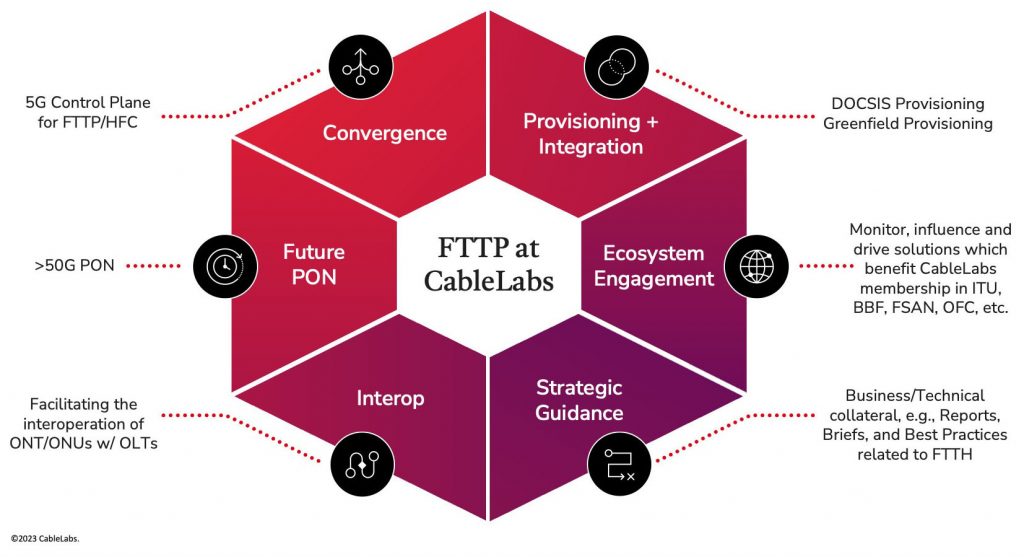
Our work toward achieving FTTP adoption extends to six pillars of activity:
Provisioning and Integration — Easily the largest scope and most important of the six pillars, provisioning and integration refers to PON technology that efficiently and seamlessly integrates with a cable operator’s existing back-office systems. Using DOCSIS-related provisioning systems to provision and manage PON technology is a great example of seamlessly integrating PON with existing cable systems. Another example: monitoring optical communication systems with tight integration with systems that monitor DOCSIS-based HFC networks.
Ecosystem Engagement — There are several large organizations that focus on standards and architectural solutions related to PON technology. The ITU and Institute of Electrical and Electronics Engineers (IEEE) are two standards development organizations with a long history of PON technology standardization, and the Broadband Forum (BBF) has focused on test plans and PON architectures. The goal of this FTTP pillar is to monitor, influence and drive solutions that benefit CableLabs membership.
Strategic Guidance — Although cable operators clearly have a long and solid history with fiber-based networks, the PON technology and extending fiber to each home come with certain service nuances. Coexisting with other generations of PON, for example, may be an area where operators could use some guidance. Virtualization of PON systems is another area where strategic guidance could be helpful.
Interoperability — One of the challenges that service providers most commonly mention is the lack of interoperability in PON solutions. For PON, interoperability is the ability for an optical line terminal (OLT) from one vendor to interoperate with optical network terminals (ONTs) from a multitude of other vendors. Multi-vendor interoperability allows a service provider to avoid vendor lock-in and use devices from multiple vendors.
Future PON — Contributing to the development of next-generation PON technology is an important role for CableLabs to ensure that cable operator requirements are considered during the development. Coherent PON (CPON) technology, currently being led by CableLabs and the cable industry, is a great example of how CableLabs can provide leadership in the telecommunications industry.
Convergence — The holy grail for service providers is providing service anytime and anywhere, regardless of the last-mile technology. Wireless, DOCSIS-based HFC and PON are all last-mile options for broadband services, and all three can achieve significant cost savings and new service revenue if converged appropriately.
From FTTP Activity to FTTP Adoption
CableLabs has pivoted some of its resources to put much more focus on these six areas of FTTP activity. We’re working with our subsidiaries Kyrio and SCTE to involve the operator and vendor community every step along the way, from the technology’s development through testing and deployment. In addition to joining working groups, our members can also access MicroLessons, training courses and other SCTE resources — all included in the CableLabs All Access program.
Participants can join our working groups anytime, but we hope you’ll get started with us from the get-go. Click the button below to join one or both of these groups and be a part of the important work to accelerate FTTP adoption. Not part of our operator or vendor ecosystem yet? It’s never too late to join. If your company’s already a participant, create an account and you’ll be on your way to accessing all of CableLabs’ benefits.

Fiber
Get Ready for 100G: CPON Architecture Specification Issued

The advancements of coherent passive optical networks (CPON) will lead to a robust and noticeable boost to the customer experience in businesses and the home. The benefits include providing faster downloads, less buffering and increased capacity for many consumer devices using applications simultaneously. Since Passive Optical Network (PON) technology was first deployed in fiber-to-the-home (FTTH) networks over 30 years ago, it has evolved from 622 Mbps to the 10 Gbps capacity being deployed by network operators today. As consumer appetite for bandwidth continues to grow, CPON will prove a scalable and extensible technology for fiber networks for the next 30 years.
Moving the Industry Closer to the Future of PON Technology
CableLabs has now issued the Architecture Specification for Coherent Passive Optical Networks (CPON) 100 Gbps (100G) Single Wavelength PON. With increased capacity per wavelength, extended reach and higher port density, CPON represents a monumental technological advancement for next-generation broadband access over fiber optic networks. The newly issued specification, first in an expected suite of specifications, will help prepare for the capacities and services needed in the future, ensuring that CableLabs members have the bandwidth and tools necessary to lead the broadband industry. This advancement in speed is a tenet of the 10G platform, with the specification ultimately bringing a faster experience to consumers, businesses and network operators.
Increased Capacity, Extended Reach
Current established PON standards, such as those developed by the International Telecommunication Union (ITU) and the Institute of Electrical and Electronics Engineers (IEEE), rely on Intensity-Modulation Direct-Detect (IM-DD) technology, which is approaching limits in terms of capacity and network reach. By contrast, 100G CPON provides the increased network capacity needed for emerging applications in high-resolution interactive video, augmented reality (AR)/virtual reality (VR)/mixed reality (MR), the metaverse, smart cities and pervasive communications. This ample capacity makes it possible to support residential broadband customers and to aggregate optical links to small businesses, enterprises and wireless access points.
CPON also introduces coherent detection for broadband access networks, enabling superior receiver sensitivity that allows for an extended optical power budget and higher spectral efficiency. Coherent detection enables 100 Gbps of capacity on a single wavelength, as well as extended reach of the network or a higher split ratio for more efficient sharing of network resources.
In addition to increasing capacity, 100G CPON extends the reach of PON over fiber networks up to 80 kilometers. Current PON technologies have trouble reaching 25 kilometers, limiting deployments to urban centers and suburban areas. Implementing these technologies at the edges of suburban areas and into rural areas commonly requires backhaul using active optical links or facilities such as fiber huts. With a fully passive optical link up to 80 kilometers, 100G CPON solves these problems and enables cost-effective deployment of FTTH in unserved areas.
OLT Ports Support More Users
Optical line terminal (OLT) ports supporting higher split ratios with CPON provide more efficient bandwidth sharing, resulting in cost savings for space, power and cooling at the hub. Current PON technologies are commonly deployed in a central office or hub location, or remotely in a node or cabinet, with each OLT port supporting a split ratio of 32:1 or 64:1. The split ratio means an OLT port shares network capacity (e.g., 10 Gbps) among 32 or 64 end users. CPON offers a split ratio up to 512:1, providing 100 Gbps to support up to 512 end users on a single OLT port while maintaining a typical reach of 25 kilometers.
The 100G CPON Architecture Specification represents the first public milestone in defining next-generation PON technology. The CPON specification working group consists of 17 optical vendors, 14 network operators, CableLabs and SCTE. If your company is interested in joining the CPON spec working group to develop the additional specifications for 100G CPON, please contact workinggroups@cablelabs.com.
Want to stay informed about CPON updates? Subscribe to the blog and get our latest news delivered straight to your inbox.

DOCSIS
CableLabs Specifications Move From De Facto to De Jure

The Merriam-Webster online dictionary defines de facto and de jure as follows:
de facto | di-ˈfak-(ˌ)tō – actual, exercising power as if legally constituted
de jure | (ˌ)dē-ˈju̇r-ē – by right, based on laws or actions of the state
In law and government, de facto describes practices that exist in reality, even though they are not officially recognized by laws, whereas de jure describes practices that are legally recognized, regardless of whether the practice exists in reality.
De facto is commonly used to refer to what happens in practice, in contrast with de jure, which refers to things that happen according to law.
The CableLabs® DOCSIS® series of specifications have been de facto standards for the cable industry for over 20 years. In parallel, CableLabs has contributed its specifications to de jure telecommunications industry standards bodies, specifically the International Telecommunications Union (ITU-T), the European Telecommunications Standards Institute (ETSI), and the Society of Cable Telecommunications Engineers/International Society Broadband Experts (SCTE/ISBE).
In the past, creating a de jure standard was a lengthy process involving the reformatting of the specifications into the standards body’s document template, proofreading the reformatting for any errors, submitting the reformatted content as a contribution, and taking it through the standards body’s standardization process. These steps could take many months or even years. Because CableLabs’ specifications are living documents under strict document control (and may have a certification program linked to revisions under this document control), the official de jure standards body’s copy can quickly become out of date. To keep the copy up to date, the process of reformatting, proofreading, submitting, and going through the standards process, has to be repeated with every revision. This reality has led to the unfortunate result that the official de jure standards have been consistently out-of-date.
However, with the SCTE/ISBE publication of the DOCSIS 4.0 standard, now all three of the relevant de jure telecommunications industry standards bodies simply normatively reference the CableLabs specifications, either directly as is the case with SCTE/ISBE and ITU-T, or indirectly as is the case with ETSI. This simplifies the revision process to one of updating a few normative references and approving them. The process of updating these de jure standards has therefore become a much more streamlined activity and the official de jure standards can remain in sync with the CableLabs specifications.
One might ask, “Why does this matter?” Quite simply, it is a matter of law versus fact, as the definitions of de facto and de jure make clear. Regional governments (“the law”) globally prefer to recognize standards that result from the due process of a de jure standards body rather than a potentially proprietary solution coming from a single manufacturer or industry consortia. The standards process will vet these solutions and typically come with an Intellectual Property Rights (IPR) policy by which all participants must abide. Now that all of the relevant de jure standards bodies have adopted this practice cable operators around the world can confidently purchase products compliant with the CableLabs specifications, knowing that they are also fully compliant with any of the official standards from the aforementioned standards bodies.
In effect, ITU-T, ETSI, and SCTE/ISBE have all recognized that the CableLabs DOCSIS specifications are not only the de facto global standard, but also the de jure global standard. There is no longer is any gap between the facts and the law.

Networks
25G/50G-EPON Standard Crosses the Finish Line – Enhancing Fiber Deployments as Part of Cable’s 10G Platform

Nobody knows the extent to which broadband speeds will continue to increase over the next 5-10 years, but service providers intend to be certain that their network solutions will be able to handle whatever is coming. With the announcement of the 10G Platform the cable industry has set a new target for future broadband speeds of at least 10 Gbps, with symmetry being a key component of that new speed target.
Whereas the majority of the cable industry continues to leverage their ubiquitous hybrid fiber coaxial (HFC) networks to provide high-speed data services to a large proportion of their subscribers, fiber to the home (FTTH) solutions that utilize passive optical networks (PON) remain an important component of their solution set. Thus, it is important for FTTH technology to continually evolve in a way that meets future bandwidth demand. I am pleased to announce PON solutions have reached a new milestone in that technology evolution with the recent approval by the Institute of Electrical and Electronics Engineers (IEEE) of the 25G/50G-EPON standard.
Key Features of 25G/50G-EPON
A key requirement for 25G/50G- EPON is it must operate over already-deployed PON infrastructure with the same split ratio and nominal 20km reach as previous generations of technology. Beyond an increase is peak capacity, there are many new features and capabilities built into this standard, some of these features are focused on the efficient use of the available capacity and reducing overhead of the media access control (MAC), while others are focused on coexisting with legacy technologies and low-cost implementations. I will focus on just a few of these enhancements to the standard.
- Peak Capacity: As the name implies, the new EPON standard developed by the IEEE 802.3ca Task Force allows for symmetric or asymmetric operation with downstream speeds of 25 Gbps or 50 Gbps, and upstream speeds of 10 Gbps, 25 Gbps, or 50 Gbps. These peak capacities are more than capable of meeting the 10 Gbps symmetric service tier goals set forth in the 10G Platform. Achieving this increase in capacity is accomplished in two ways: (1) expanding the transmission rate to 25 Gbps per wavelength and (2) leveraging wavelength division multiplexing technology to add an additional wavelength. A benefit of this architecture is that service providers can initially deploy a single wavelength providing 25 Gbps, and then add a second wavelength to bring the total to 50 Gbps upon demand.
- Coexistence: An important consideration for service providers is the ability to support coexistence with legacy PON technologies, specifically 10 Gbps PON. Briefly, coexistence enables reuse of existing PON infrastructure by easily adding additional capacity while avoiding the complete removal of legacy PON technology. For 25G/50G-EPON, service providers who have already deployed 10G PON solutions are able to add one or more 25 Gbps wavelengths to bring total capacity to 35 Gbps or 60 Gbps in total over the same PON infrastructure. Various coexistence scenarios are shown in the diagram below.

- Low-Cost Implementation: The economics of any residential broadband solution are always an important consideration for service providers. For optical solutions such as PON, the optical transceiver on each end of the link is one of the more costly components. Particularly for FTTH PON solutions, it is critical to keep costs as low as possible for the customer premise equipment, the optical network unit (ONU) in the case of EPON. In this regard, 25G/50G-EPON aggressively strives to keep ONU optical component costs low in two key ways: (1) fixed wavelengths, instead of tunable wavelengths, and (2) wideband optics in O-band without dispersion compensation. In fact, in greenfield deployments, e.g. new FTTH builds unburdened with legacy PON technology, a 50 Gbps ONU can use two wideband channel sources to reduce costs instead of two narrowband channel sources or operating 50 Gbps on a single wavelength, as shown in the lower portion of the figure above.
Speed, coexistence and low-cost implementations are only three of the outstanding benefits built into the next generation of EPON. Without a doubt this version of PON technology represents the lowest cost per bit compared with any other PON technology. If you are interested in looking for future activities at CableLabs related to integration of this technology into cable networks or discovering more details about 25G/50G-EPON, please feel free to contact us to receive more information.

Wired
Debunking the Myths of Shared Networks: The Point-to-Multipoint Effect

“I don’t want to have to share a pipe. The problem with ‘cable’ is shared pipes. If my neighbor is doing a bunch of stuff over the network, I get impacted too. With fiber I get speed and no shared pipes.”
--- Entrepreneur in a focus group
The notion that subscribers connected to residential fiber networks do not “share pipes” is often misunderstood. For residential fiber networks, sharing pipes is one of the main reasons fiber to the home (FTTH) is even remotely cost-effective for service providers to deploy. But what is most surprising is the following: deploying shared network solutions has led to a more rapid increase in residential broadband speeds than otherwise would have been the case with non-shared access network solutions. I like to call this the Point-to-Multipoint Effect. In the process, sharing pipes has allowed broadband speed growth to surpass the predicted 50% compounded annual growth rate commonly known as Nielsen’s Law of Internet Bandwidth. Read on to learn more…
First, a couple of definitions:
- A (non-shared) point-to-point (P2P) network topology is one in which there is a single dedicated connection between two endpoints. In the case of access networks, one endpoint is typically located at the hub or central office, or could be located at a remote distribution point. The other endpoint is a digital subscriber line (DSL) modem, for example, or a simple Ethernet switch, located on the customer premise. In P2P networks, the peak capacity of a link is used exclusively by only the two endpoints.
- A (shared) point-to-multipoint (P2MP) network topology is one in which there is a single downstream transmitter and multiple access termination devices that all selectively listen to the same downstream data stream. A key characteristic with P2MP networks is the peak capacity of the network is shared between all connected endpoints. Two examples of P2MP networks are HFC and passive optical networking (PON), shown in the figure below (showing downstream transmission).

Two examples of (shared) point-to-multipoint networks: HFC and PON
The PON solution represents the most prevalent residential fiber solution in the world, primarily due to lower costs compared to P2P fiber solutions. To illustrate the sharing, referring to the diagram above, if 10G-EPON is the technology choice, each optical network unit (ONU) connected to the network transmits upstream at ~10 Gbps, but they don’t transmit simultaneously. Instead, an ONU must be scheduled by the OLT for upstream transmission to avoid collisions with other ONUs. In essence, the scheduling of ONUs results in the sharing of the 10 Gbps peak capacity. Consequently, there is a whole lotta pipe sharing going on in PON solutions.
Do shared networks necessarily perform better or worse than non-shared networks? It depends on how performance is measured, but in one key area, residential broadband speeds, shared networks have significantly outperformed non-shared networks by a substantial amount.
A recent blog discussed Nielsen’s Law of Internet Bandwidth and how the cable industry was preparing to meet future broadband speeds with 100G-EPON. When Mr. Nielsen made his initial prediction in 1998, residential broadband access was dominated by dialup and ISDN connections, which are both P2P solutions. Indeed, for approximately the first 14 years since that initial 300 bits per second dialup connection in 1982/1983, the progression of available peak service tier bit rates followed the 50% annual growth rate prediction.

**various sources compiled by CableLabs
The release of the first DOCSIS® specifications by CableLabs in 1996 essentially represented the dawn of P2MP solutions, i.e. shared, for residential Internet connectivity. According to the data in the chart above, the tremendous rate of technology advancements resulting from the shared DOCSIS/HFC network solution, and later with the development of shared PON technologies, coupled with the relative cost-effectiveness of these solutions, has far exceeded other P2P technologies for residential broadband. While the initial growth prediction in 1998 was a 50% annual growth rate, the Point-to-Multipoint Effect increased the growth rate closer to 70% for residential Internet connectivity. The Point-to-Multipoint Effect indicates that sharing pipes for residential connectivity has provided a solution that has actually allowed residential high speed data rates to increase at a faster pace! This “sharing” trend is expected to continue with the development of Full Duplex DOCSIS and 100G-EPON, making the introduction of new services possible. Thus, just like our parents always told us, it is good to share.
In his role as Vice President Wired Technologies at CableLabs, Curtis Knittle leads the activities which focus on cable operator integration of optical technologies in access networks. Curtis is also Chair of the 100G-EPON (IEEE 802.3ca) Task Force.
Networks
Keeping Pace with Nielsen’s Law
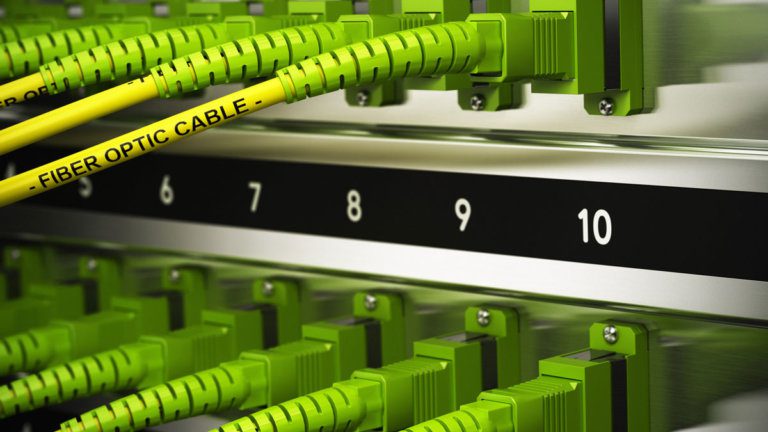
The telecommunications industry typically uses Nielsen’s Law of Internet Bandwidth to represent historical broadband Internet speeds and to forecast future broadband Internet speeds. Mr. Nielsen predicted many years ago the high-end user’s downstream connection speed grows by approximately 50% compound annual growth rate (CAGR). In reality, actual peak service tiers offered by service providers over the years may be following something closer to 60% compound annual growth rate, as shown in the figure below.
The point of this blog is not to debate whether the growth rate is 50% or 60%, but rather if the growth rate continues, how do we evolve our networks to keep pace?
For point-to-multipoint networks there is a general rule of thumb for determining the peak service tier given a particular peak network capacity. This capacity-to-peak-tier ratio of 2:1 isn’t necessarily based in scientific fact, but comes from years of experience that a 2:1 ratio allows service providers to have a reasonable level of confidence that speed test measurements will accurately reflect a user’s subscription level. For example, for a particular access network technology, if the network supports 2 Gbps transmission rates to/from the access termination device (i.e., a cable modem) then the peak service tier typically won’t exceed 1 Gbps.
The present state of the art access network technology peaks at 10 Gbps[1]. The IEEE 802.3 10 Gbps Ethernet Passive Optical Network (10G-EPON) has been deployed in China and the United States. ITU-T has recently consented XGS-PON, another 10 Gbps symmetric PON standard that uses the physical layer of XG-PON (ITU-T G.987.2) and 10G-EPON. Even the ITU-T’s NG-PON2 standard, which uses multiple wavelengths to increase network capacity, only defines a single wavelength per optical network unit (ONU), which puts NG-PON2 on par with 10G-EPON and XGS-PON in terms of meeting peak service tier rates. Finally, CableLabs is now certifying DOCSIS 3.1 devices which are capable of 10 Gbps downstream, and soon will certify 10 Gbps symmetric devices based on Full Duplex DOCSIS technology. What does this mean for accommodating Nielsen’s Law? Assuming the peak service tier trends continue, and given the 10 Gbps peak network capacity of current solutions, the maximum peak service tier will level off at approximately 5 Gbps (see red dashed line in chart above) until technology advances to allow higher rates. The telecommunications industry needs a technology roadmap beyond the current state of the art which allows for peak service tiers to exceed 5 Gbps.
CableLabs and its members, along with other service providers and the IEEE, are determined to stay ahead of the trends displayed in the graph above by contributing to the world’s first 100 Gbps EPON solution as part of the IEEE 802.3ca Task Force. The prevailing sentiment of the 802.3ca Task Force is to create a generational standard that allows for growth of peak network capacity (and corresponding peak service tiers) if and when such growth becomes necessary, without creating a new standard. This growth is expected to be achieved through defining four wavelengths, with each wavelength supporting 25 Gbps. Initial product developments will revolve around a single wavelength to provide a 25 Gbps EPON solution. When market conditions demand it, using two wavelengths along with a channel bonding solution will allow an ONU to transmit and receive at up to 50 Gbps. Similarly, with four wavelengths and channel bonding the ONU will transmit and receive at up to 100 Gbps. Examining the chart above, and assuming historical trends continue, the reader can see the 100G-EPON standard will support peak service tiers out to approximately 2030, give or take a couple years, assuming the 50% CAGR predicted by Nielsen continues.
One of the interesting facets of the 802.3ca Task Force activities relates to the improvement in efficiencies in the media access control (MAC). Previously, the IEEE 802.3 standard did not allow frame fragmentation, but recently with the completion of the IEEE 802.3br Interspersing Express Traffic Task Force, frame fragmentation is now allowed in networks based on the 802.3 standard. The 802.3ca Task Force plans to leverage fragmentation to make transmission more efficient in a multi-wavelength, channel-bonded environment. Additionally, contributions to the 802.3ca Task Force will improve the efficiency of the upstream bandwidth allocation process by allowing multiple service flow queue depth reporting and upstream granting in a single message pair. Considering the ITU-T SG15/Q2 is also investigating 25 Gbps per wavelength, the more promising and exciting aspect of these 802.3ca Task Force decisions is that the next generation of IEEE EPON and ITU-T GPON standards could be more closely aligned than ever before in the very near future! This makes a converged optical access solution closer to reality. (see a previous blog regarding a converged optical access initiative)
In his role as Vice President Wired Technologies at CableLabs, Curtis Knittle leads the activities which focus on cable operator integration of optical technologies in access networks. Curtis is also Chair of the IEEE 802.3ca Task Force.
[1] I’m ignoring point-to-point fiber solutions such as Active Ethernet because these are not typically residential solutions.
Cable Information Architecture
Passive Optical Networking – for the Next Generation
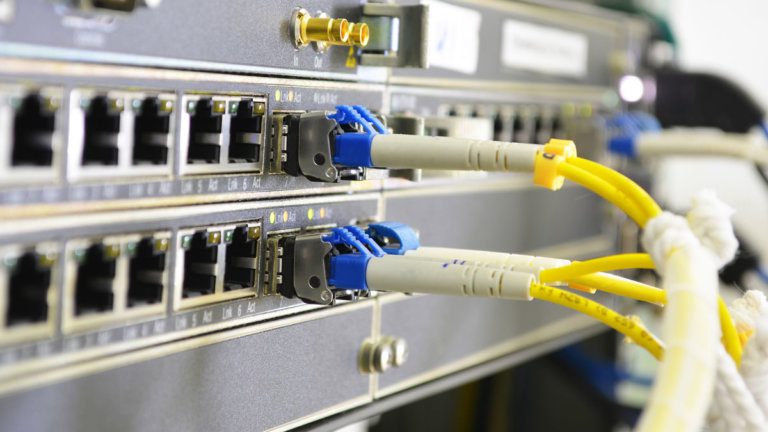
Service providers invest billions of dollars in their access networks. Ideally, the deployed technology meets consumer demand for many years, allowing service providers to avoid costly upgrades before fully recovering their investments. In addition to technology longevity, service providers also like to see technology evolution, a next generation, to borrow an overused technology term, to ensure future consumer demands can be met by staying within the same technology family. Nowhere is the next generation moniker more prevalent than in the development of passive optical networking (PON) standards.
Both the ITU-T and IEEE are creating next generation PON standards. The ITU has approved two documents from their G.989 series defining Next Generation PON 2 (NG-PON2), and a third document is currently undergoing final comments. The NG-PON2 architecture settled on a time and wavelength division multiplexing (TWDM) method which stacks four wavelengths in a coordinated manner onto a single fiber, with each wavelength delivering 10 Gb/s. Total NG-PON2 TWDM-PON capacity is therefore 40 Gb/s. Since the ONU only receives one wavelength, the bit rate received by a single ONU is capped at 10 Gb/s. In such a solution, the dynamic bandwidth allocation (DBA) would likely be independent for each wavelength. Multiple vendors have reported demonstrating the TWDM-PON solution. A four-wavelength TWDM-PON is illustrated in the figure below.

40 Gb/s Time and Wavelength Division Multiplexing (TWDM) PON.
Is a 100 Gb/s Solution on the Horizon?
The IEEE 802.3 Working Group has recently formed a Study Group to develop objectives for the next generation of Ethernet Passive Optical Networking (NG-EPON). Several key technology decisions await the NG-EPON Study Group: (1) number of wavelengths, (2) bit rate per wavelength, (3) transceiver tunability, and (4) channel bonding. Faced with the same consumer demands and industry competition as other access network technologies, the NG-EPON Study Group could relatively easily define a four-wavelength, 10 Gb/s-per-wavelength PON to put it on par with NG-PON2, shown above. However, alternative solutions are being investigated by NG-EPON participants that would take PON technology multiple steps beyond, and presumably allow consumer demand to be met for many years into the future. For example, using advanced modulation techniques to provide 25 Gb/s per wavelength, combined with four multiplexed wavelengths on a single fiber, could yield the first 100 Gb/s PON solution. By incorporating channel bonding, a concept popularized by CableLabs and the cable industry in the DOCSIS® 3.0 specifications, an NG-EPON ONU would be capable of receiving one or more wavelengths, potentially receiving 50 Gb/s or more. In a channel-bonded solution the DBA will closely coordinate upstream transmissions on one or more wavelengths simultaneously. Are the optical transceivers tunable? That is another of the many important technology decisions yet to be made. A channel-bonded, time-wavelength division multiplexed PON is shown in the diagram below.

Channel-bonded, time and wavelength division multiplexed 100 Gb/s PON.
With a keen eye on vendor implementation schedules and interoperability, the increased capacity of NG-EPON ONUs and OLTs could be staged according to a timeline that aligns with consumer demand and service provider requirements, alleviating the need to develop yet another next generation standard (next-next generation?).
These technology decisions will begin to take shape within the NG-EPON Study Group (and subsequent Task Force) starting at the September 2015 802.3 Interim meeting. Anyone with the desire to contribute is welcome to attend. Perhaps the ITU-T will also investigate these same approaches for NG-PON2, ultimately resulting in another step toward a converged optical access solution (See the OnePON blog regarding a converged optical access initiative).
In his role as Vice President Wired Technologies at CableLabs, Curtis Knittle leads the activities which focus on cable operator integration of optical technologies in access networks. Curtis is also Chair of the 100G-EPON (IEEE 802.3ca) Task Force.
Networks
OnePON™: Addressing the Alphabet Soup of PON

APON, BPON, EPON, GEPON, GPON, G.epon, NGPON1, XGPON1, XGPON2, NGEPON, NGPON2, TWDM-PON, WDMPON – did I leave any out? I’m sure I did.
The alphabetical possibilities to represent different versions of passive optical networking (PON) technologies will soon be exhausted. I’m being overly dramatic, of course, but trying to make the point that all these different versions of PON, driven by membership in two somewhat competing standards development organizations, not only causes the eyes of network engineers to glaze over, but has contributed to confusion and indecision among service providers globally.
What is a PON?
In the strictest sense, a PON is an all-fiber network which consists of only passive optical components (specifically splitters and combiners), except at the endpoints of each fiber, where there is an electrically-powered termination device – either an optical line terminal (OLT) or optical network unit (ONU). The aforementioned PON technologies also assume a point-to-multipoint topology in which downstream transmission from an OLT is received by all ONUs, but upstream transmission by an ONU is received only by the OLT.
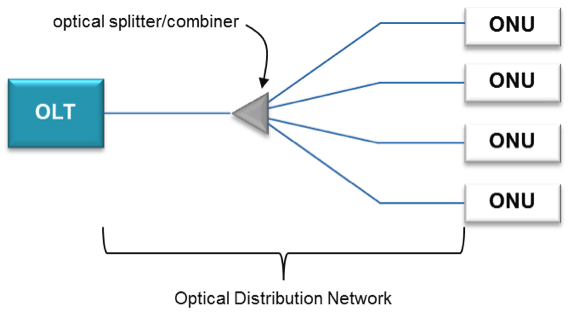
Admittedly, not all of the acronyms above represent actual PON standards, so here is an unofficial, very short description of the meaning of each acronym:
APON (ATM PON) – The first PON technology standardized by the ITU. APON used Asynchronous Transfer Mode (ATM) cells to transport data across the PON. APONs typically provided up to 622 Mbps downstream and up to 155 Mbps upstream.
BPON (Broadband PON) – ATM is known to be an inefficient transport technology, so APON was renamed to BPON to distance the technology from ATM, even though it still used ATM for transport. Supported bit rate also increased to 1.2 Gbps downstream and 622 Mbps upstream, but most (all?) were deployed at 622 Mbps downstream and 155 Mbps upstream.
EPON (Ethernet PON) – The first PON standard developed by IEEE which uses Ethernet frames to transport data across the PON. 1G EPON provides symmetric 1 Gbps links, while 10G EPON provides symmetric 10 Gbps links. There is also a variant that provides 10 Gbps downstream and 1 Gbps upstream.
GEPON (Gigabit Ethernet PON) – Many people use GEPON to refer to EPON. Others use GEPON to refer to an early, unstandardized version of 100 Mbps PON used in Japan.
GPON (Gigabit PON) – A non-ATM based PON standard from the ITU which uses GPON Encapsulation Method (GEM) to transport Ethernet frames, ATM cells, and native TDM data across the PON. GPON provides 2.5 Gbps downstream and 1.25 Gbps upstream. ATM and TDM are de-facto obsolete, and no GPON equipment supports it, resulting in a network solution which also transports only Ethernet frames – like EPON.
G.epon (EPON with a GPON flavor) – Not to be confused with GEPON, which existed first, G.epon is an ITU term used for EPON devices which can be configured using the GPON mode of ONU configuration called ONU Management Control Interface (OMCI).
NGPON1 (Next Generation GPON) – ITU name for a family of 10 Gbps PON standards (see XGPON1 and XGPON2) – this was the first “next generation” activity in the ITU.
XGPON1 / XGPON2 (10G GPON) – XGPON1 represents an ITU standardized versions of GPON capable of 10 Gbps downstream and 2.5 Gbps upstream. XGPON2 was supposed to represent symmetric 10G bps GPON, but it was never completed.
NGEPON – This is the name for the current IEEE activity to define an EPON standard beyond 10 Gbps – the next generation of EPON.
NGPON2 – This is the name for the current ITU activity to define a family of post-10 Gbps GPON solution(s) - the second “next generation” PON effort in the ITU. The technology of choice for this new standard uses Time and Wavelength Division multiplexing – the origin of the TWDM-PON acronym.
I’m sure I missed a few hyphens in all those acronyms, but I give up! It’s definitely clear as mud, right? Actually, it is very challenging to explain all the different PON standards and terminology. The bottom line is, service providers today are forced to choose between two PON solutions that do exactly the same thing – transport Ethernet frames from one side of an optical distribution network to the other side. Judging from the NGEPON (IEEE) and NGPON2 (ITU) activities, it looks like the madness will continue and the industry will have two next generation PON standards to choose from, much to the disadvantage of both service providers and vendors.
Learning from the Wireless Industry
Once upon a time in the wireless industry there were several competing standards simultaneously operating: GSM, North American TDMA, and Qualcomm’s CDMA. In addition, around the year 2000, WiMax made an entrance. These competing standards operated for anywhere between 8 and 12 years. Around 2006 the GSM/TDMA/CDMA trifecta finally converged to become what is today the LTE wireless standard. The interesting aspect of this technology convergence is the affect on CPE dongle pricing, as shown in the graph below.
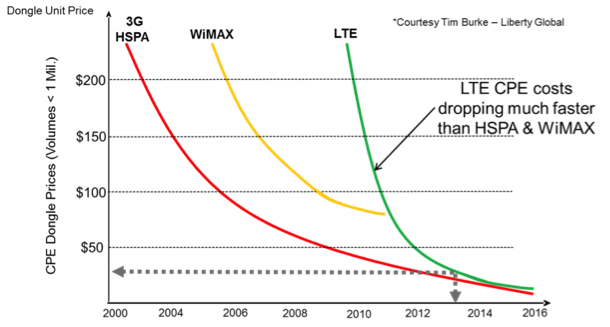
Clearly, a single technical solution drives prices downward much quicker by achieving truly global scale. This has been a huge benefit for wireless service providers. Also beneficial for wireless device vendors, they get to focus their precious and limited development dollars on a single technical solution for the entire wireless market.
OnePON™ Initiative
Clearly the global telecommunications industry does not need two different technologies to transport Ethernet frames across a PON. Today, the IEEE and the ITU are both working on yet another generation of PON standards which will continue the alphabet soup trend and continue to bifurcate the PON market. If the wireless industry may serve as an example, this will force service providers to unnecessarily pay higher prices, and device manufacturers to spend nearly twice the amount for product development if they wish to target the entire market.
The CableLabs OnePON™ Initiative is building toward creating a single PON solution that satisfies the requirements of the global service provider market. OnePON™ is not EPON, and it is not GPON. A third standardized PON solution is not a goal of the OnePON™ Initiative. On the contrary, the goal is to combine the best aspects of both IEEE and ITU solutions to create a single next generation solution. Service providers will reap the benefits of lower capital expenses for network deployments. Vendors will be able to focus on a single technical solution for PON which addresses the global PON market, resulting in saving a tremendous amount of development costs (compared to two PON solutions), which will help translate directly to lower costs for service providers.
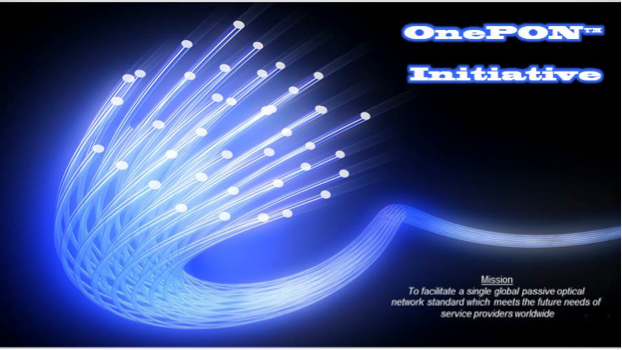
As Director of Optical Technologies at CableLabs, Curtis Knittle leads the activities which focus on standardizing EPON and GPON technologies for use in cable operator networks. On a daily basis he witnesses firsthand the challenges and increased costs associated with two similar PON technologies.


